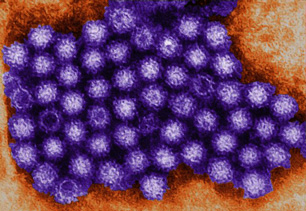Norovirus
| EPA Maximum Contaminant Level Goal (MCLG) |
zero |

Norovirus is the name of a group of viruses in the Caliciviridae family, named for the original strain, the Norwalk virus, discovered during an outbreak of the disease at an elementary school in Norwalk, OH, in 1968.
Sources of Norovirus
-
Norovirus is spread through poor toilet hygiene, drinking infected water or eating infected food, and through contact with infected people or surfaces.
-
It is often associated with septic, sewer or fecal contamination of private wells, small water systems, community water systems, recreational waters and pools. Cross-connection of sewage and drinking water systems is a cause.
-
Washing food with contaminated water is a cause, as is eating shellfish (raw or steamed) from polluted waters.
Health Effects of Norovirus
Norovirus causes a form of gastroenteritis sometimes called “winter vomiting disease” or “stomach flu.” A common disease, but usually not fatal, with no long-term effects. Vulnerable people (children, elderly, immuno-compromised) may require medical attention.
Water Treatment for Norovirus
Reverse osmosis, nanofiltration and some ultrafiltration systems are the preferred treatment methods, but a variety of disinfection methods may be effective, including chemical oxidation, ultraviolet, distillation, etc. Note that noroviruses have survived in water with up to 10 parts per million (ppm) chlorine, well above public drinking water levels.
Source: Water Technology Magazine, Volume 32, Issue 2 - February 2009, Image: CDC/ Charles D. Humphrey
Site Index
Filtration Systems
- Aeration for Iron & Sulfide
- Backwashing Filters
(whole house & well units)
- Chlorine & Chemical Injectors
- Countertop Water Filters
- Emergency Filters
- Garden Hose Filters
- Reverse Osmosis, Residential
- Reverse Osmosis, Commercial
- Shower Filters
- Specialty Filters
- Ultraviolet Systems
- Undersink Filters
- Water Softeners
- Whole House Filters
Cartridges
Parts
- Replacement Parts
- Faucets
- Filter Media
- Fittings
- Housings
- O-rings
- Pumps
- Pura UV
- R.O. Parts
- R.O. Tanks
- R.O. Booster Pump
- VIQUA UV